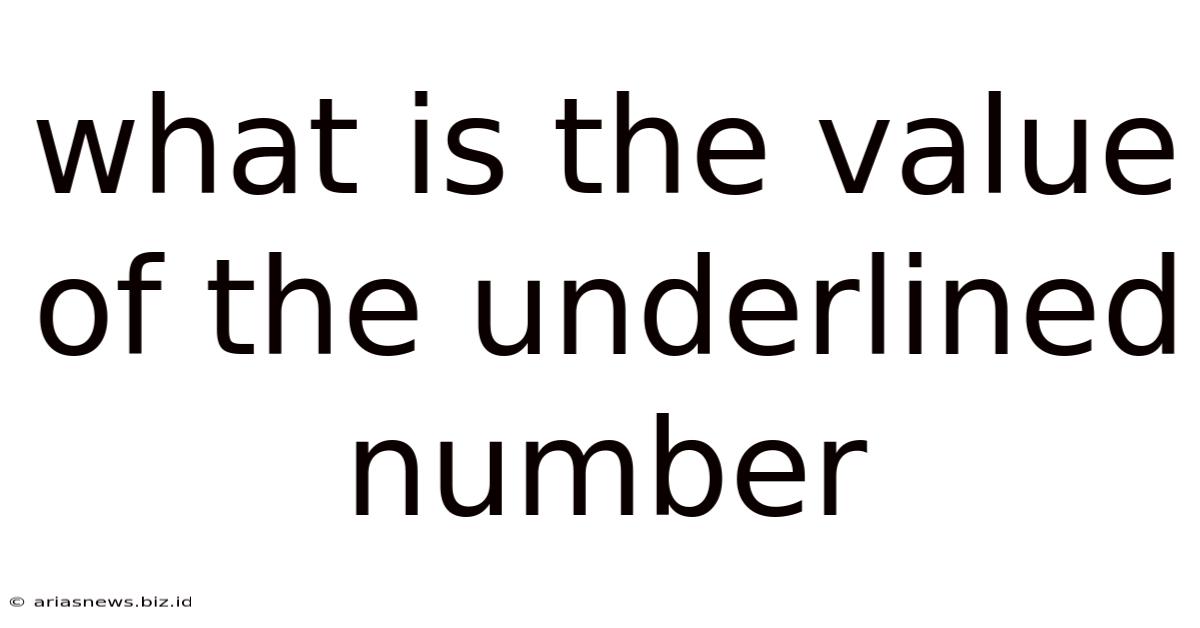What Is The Value Of The Underlined Number
Arias News
May 11, 2025 · 5 min read

Table of Contents
What is the Value of the Underlined Number? A Deep Dive into Place Value and Number Systems
Understanding the value of an underlined number depends entirely on its context. There's no single answer; the value is relative to its position within a larger number, the number system being used (decimal, binary, hexadecimal, etc.), and even the specific problem it's part of. This article will explore various scenarios to illuminate how to determine the value of an underlined number.
Understanding Place Value: The Foundation
The cornerstone of understanding numerical value is grasping the concept of place value. In a positional number system (like the decimal system we commonly use), each digit's position relative to the decimal point (or radix point in other systems) dictates its contribution to the overall number's value.
Let's illustrate with the decimal system (base 10):
- Ones (Units) Place: The rightmost digit represents the number of ones.
- Tens Place: The digit to the left of the ones place represents the number of tens.
- Hundreds Place: The digit to the left of the tens place represents the number of hundreds.
- Thousands Place: The digit to the left of the hundreds place represents the number of thousands, and so on.
Example: In the number <u>3</u>,257, the underlined digit 3 represents 3,000 (three thousand). Its value is determined by its position in the thousands place.
Exploring Different Number Systems
While the decimal system is prevalent in everyday life, other number systems exist, each with its own place value system.
Binary (Base 2)
The binary system uses only two digits: 0 and 1. Each position represents a power of 2.
- Ones Place: 2<sup>0</sup> = 1
- Twos Place: 2<sup>1</sup> = 2
- Fours Place: 2<sup>2</sup> = 4
- Eights Place: 2<sup>3</sup> = 8, and so on.
Example: In the binary number 1<u>0</u>11, the underlined digit 0 represents 0 x 2<sup>2</sup> = 0. Its value is zero because it's in the fours place and holds a zero value.
Hexadecimal (Base 16)
The hexadecimal system uses 16 digits: 0-9 and A-F, where A represents 10, B represents 11, and so on, up to F representing 15. Each position represents a power of 16.
- Ones Place: 16<sup>0</sup> = 1
- Sixteens Place: 16<sup>1</sup> = 16
- Two Hundred Fifty-Six Place: 16<sup>2</sup> = 256, etc.
Example: In the hexadecimal number A<u>F</u>2, the underlined digit F (representing 15) is in the sixteens place. Its value is 15 x 16<sup>1</sup> = 240.
Context Matters: Scenarios and Examples
The value of the underlined number is deeply intertwined with the context of the problem. Let's explore several scenarios:
Scenario 1: Simple Whole Numbers
In the number 1<u>2</u>,345, the underlined digit 2 represents 2,000 (two thousand). Its value is clearly defined by its position in the thousands place.
Scenario 2: Decimal Numbers
The decimal point significantly alters the place values. Digits to the right of the decimal point represent fractions of one.
Example: In the number 12.<u>3</u>45, the underlined digit 3 represents 3/10 or 0.3. Its value is three-tenths.
Scenario 3: Scientific Notation
Scientific notation expresses numbers as a product of a number between 1 and 10 and a power of 10.
Example: In the number 1.<u>2</u>3 x 10<sup>4</sup>, the underlined digit 2 represents 2 x 10<sup>3</sup>, which equals 2,000.
Scenario 4: Significant Figures
In scientific calculations, significant figures denote the precision of a measurement. The value of underlined digits within a number expressed in significant figures depends on their position and whether they are considered significant or not. Zeroes are often tricky. Leading zeroes are not significant; trailing zeroes are only significant if a decimal point is present.
Example: The number 0.00<u>1</u>20 has only two significant figures (1 and 2). The underlined digit '1' is significant, holding a value of 1 x 10<sup>-3</sup> (0.001).
Scenario 5: Algebraic Expressions
In algebraic expressions, underlined numbers may represent variables or unknowns. The value then becomes a matter of solving the equation.
Example: In the equation 2x + <u>y</u> = 7, the value of the underlined 'y' depends on the value of 'x' and solving for 'y'.
Scenario 6: Complex Numbers
Complex numbers have a real and an imaginary part. The value of an underlined digit depends on which part it is in.
Example: In the complex number <u>2</u> + 3i, the underlined 2 represents the real component with a value of 2.
Advanced Concepts
Let's briefly touch upon some more advanced concepts that can impact the value of an underlined number:
-
Different Bases: Understanding the base of a number system is paramount for accurate value assessment. Working in base 8 (octal), base 12 (duodecimal), or even higher bases requires adjusting how we interpret place value.
-
Rounding: Rounding affects the value of digits, especially those near the rounding point. The context (whether rounding up or down) is crucial.
Conclusion: The Importance of Context
Determining the value of an underlined number is not a simple exercise. It necessitates understanding the numerical system employed, the position of the digit within the number, the presence of a decimal point, significant figures, and the overall context of the problem. By carefully considering these factors, we can accurately ascertain the value of any underlined number, regardless of its complexity. This detailed exploration highlights the importance of fundamental number sense and the critical role of context in mathematical interpretation. Remember to always carefully examine the situation to determine the correct value. The underlined digit doesn't possess inherent value; its value is entirely dependent on its surroundings.
Latest Posts
Related Post
Thank you for visiting our website which covers about What Is The Value Of The Underlined Number . We hope the information provided has been useful to you. Feel free to contact us if you have any questions or need further assistance. See you next time and don't miss to bookmark.